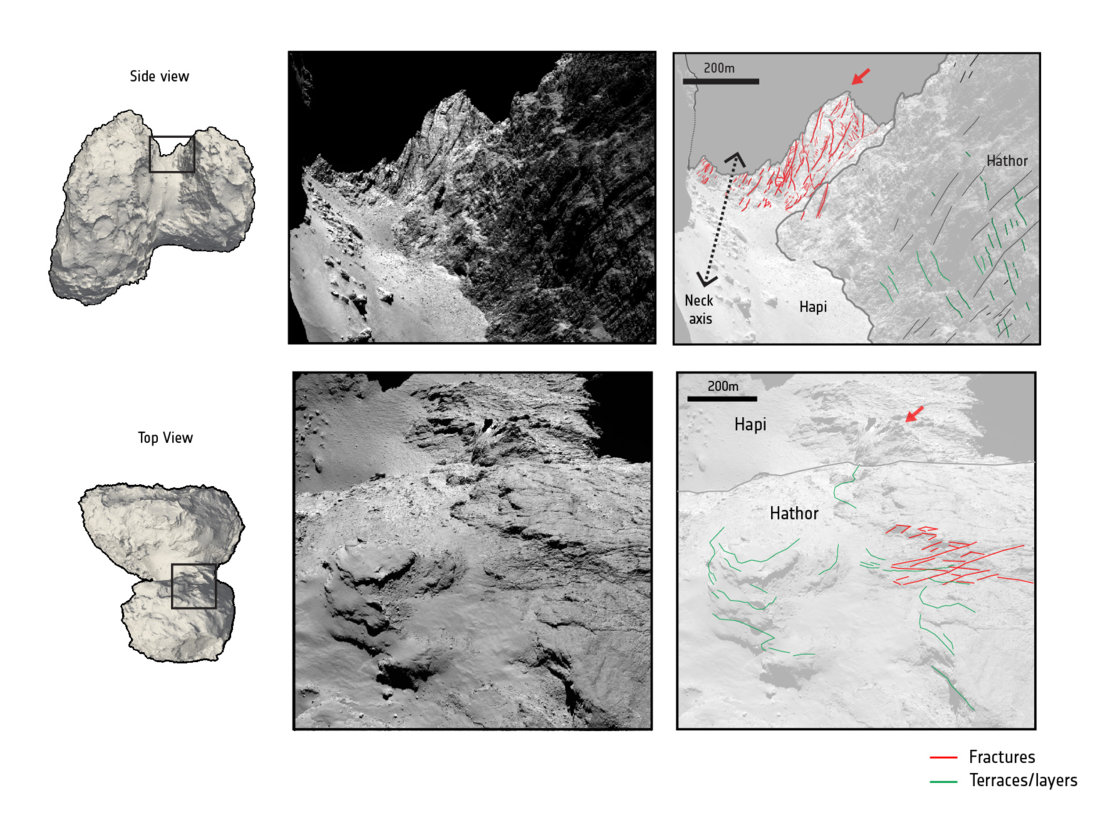Under Pressure: Rosetta Comet's Weird Neck Sculpted By Shear Stress

The weird "neck" between the lobes of Comet 67P/Churyumov-Gerasimenko spotted by the Rosetta spacecraft formed in part because the comet had a brittle interior, a new study shows.
Pictures of 67P taken by Rosetta between 2014 and 2016 — coupled with new modeling and three-dimensional analyses — revealed networked faults and fractures in the comet that stretched as far as 1,640 feet (500 meters) underground and hundreds of feet or meters wide. The stress peaked at the thinnest part of the comet's neck, which connected the two lobes of 67P.
The discovery not only helps scientists understand 67P, but also how comets in general were formed around the solar system, researchers said in a statement about the new research. These tiny worlds of ice and dust circle the Sun; as they move closer to the star's warmth and particle pressure, ice boils off directly into space in a process called sublimation. This process often creates a tail of water vapor protruding from the comet. But sublimation alone cannot explain the presence of the newly found cracks in 67P, the researchers said. [In Images: Rosetta Spacecraft's Last Comet Photos During Crash-Landing]
"These geological features were created by shear stress, a mechanical force often seen at play in earthquakes or glaciers on Earth and other terrestrial planets, when two bodies or blocks push and move along one another in different directions," Christophe Matonti, lead author of the new report and an astrophysicist at Aix-Marseille University in France, said in the statement. "This is hugely exciting: it reveals much about the comet's shape, internal structure, and how it has changed and evolved over time."

"It's as if the material in each hemisphere is pulling and moving apart, contorting the middle part — the neck — and thinning it via the resulting mechanical erosion," co-author Olivier Groussin, an astronomer at Aix-Marseille University, added in the same statement. "We think this effect originally came about because of the comet's rotation combined with its initial asymmetric shape. A torque formed where the neck and 'head' meet, as these protruding elements twist around the comet's center of gravity."

While sublimation dies down during 67P's furthest point from the Sun — beyond Jupiter's orbit to almost 6 Earth-sun distances (called astronomical units) away — the stress would continue to act over the billions of years since the comet was formed, the researchers said.
While the stress is small, the effects would accumulate over time. Sublimation would affect the comet much more rapidly over millions of years, researchers said in the statement. Sublimation is maximal when 67P skirts inside Mars' orbit for its closest approach to the sun, every 6.5 years. (A billion years is equal to 1,000 million years; the solar system is roughly 4.5 billion years old, for perspective.)
Breaking space news, the latest updates on rocket launches, skywatching events and more!

After swinging past Pluto in 2015, NASA's New Horizons spacecraft came close to another dual-lobed object when it flew by 2014 MU69 (which NASA nicknamed Ultima Thule) on Jan. 1. The object is embedded in a region called the Kuiper Belt, a huge reservoir of comets and small objects beyond Neptune. While analysis is ongoing, so far researchers haven't spotted any sign of shear stress in MU69, Mantoni said.
A study based on the research was published Feb. 18 in the journal Nature Geoscience.
Follow us on Twitter @Spacedotcom and on Facebook.
Join our Space Forums to keep talking space on the latest missions, night sky and more! And if you have a news tip, correction or comment, let us know at: community@space.com.

Elizabeth Howell (she/her), Ph.D., was a staff writer in the spaceflight channel between 2022 and 2024 specializing in Canadian space news. She was contributing writer for Space.com for 10 years from 2012 to 2024. Elizabeth's reporting includes multiple exclusives with the White House, leading world coverage about a lost-and-found space tomato on the International Space Station, witnessing five human spaceflight launches on two continents, flying parabolic, working inside a spacesuit, and participating in a simulated Mars mission. Her latest book, "Why Am I Taller?" (ECW Press, 2022) is co-written with astronaut Dave Williams.
